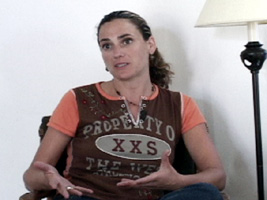 |
|
Interview
with Erica Zeitlin
No More Sweatshops, Campaign for the Abolition
of Sweatshops and Child Labor
Los Angeles, California
July 26, 2004
Erica Zeitlin works with the
coalition No More Sweatshops on anti-sweatshop
procurement policies in Los Angeles.
mR: microRevolt
EZ: Erica Zeitlin
|
|
mR: If you could start by
giving us a little background about how the dawn of sweatshops
relate to what is going on with today's sweatshop crisis.
EZ: Well first of all, I
just think it’s important for people to remember that
the crisis that we’re facing today in terms of sweatshop
labor as part of the global marketplace is nothing new. It’s
just a 21st century version of what’s happened before
under different economic circumstances and different historical
circumstances.... You could say roughly from the 1830s- to
the 1930’s there was periodic struggle and uprising
of immigrant workers to wipe out sweatshop conditions. Once
again we are facing very similar kinds of conditions in factories
today. There’s very different reasons for the resurgence
of sweatshops, of course. Today we talk about globalization
and we talk about the loss and hemorrhaging of American jobs
overseas in the manufacturing sector. It’s a very
complex story but the fact is that we have sweatshop labor
and child labor in the United States once again -- and, of
course, outside of the United States. You could estimate
that about 2 billion people today in the world are surviving
on less than 2 dollars a day. Most Americans can’t
even conceive of that kind of an income. But that’s
the reality.
What’s more disturbing is that in many
cases, the workers and children working in these factories
overseas are working for American companies, American multinationals,
that are exploiting these people for the lowest possible pay
rate that they can get away with. And so once again you see
that there’s a movement that’s sprung up in the
last decade or so in the U.S., starting with students in college
campuses across the country, in which people are demanding
once again fair labor practices and a sense of human decency
in the treatment of workers. Let me briefly mention that most
people don’t realize Los Angeles today, where I live
and where I work, is the sweatshop capital of the United States.
mR: When you say that people
don’t know that, do you mean locally or nationally?
EZ: I don’t think most
people are aware that we basically live in two Americas today.
There’s such a gap in income between the wealthy and
the poor in this country, and that gap has increased so much,
so dramatically in recent years at an unprecedented rate,
really, as a result I think most middle class people in this
country aren’t even aware that in these larger cities
such as Los Angeles, New York and Chicago, you can drive 15
minutes and be in an entirely different economic climate in
an underground economy, you could say the ugly under-belly
of an economy. So I’m a middle class worker but I live
a short drive from people who are earning far less than the
legal minimum wage, in conditions that are unsanitary, very
little air, no water, very few bathroom breaks, they’re
treated essentially like servants, in many cases these workers
have accepted these conditions to some extent because they’re
very vulnerable. Many of them are undocumented workers and
they fear being deported if they complain.
mR: So you’re saying
a lot of the workers that are working in these conditions
are immigrant workers?
EZ: Yeah, I’m not sure
of the exact percentage but certainly it’s the case
that most sweatshop workers in the United States are new immigrant
workers, poor immigrant workers, many of them are Latinos
from Mexico, from Central America, many others from the Far
East.
mR: How do you gain sympathy
among the American middle class to be sympathetic to these
immigrants?
EZ: Well it’s a terrific
question and it’s one that I’ve thought about
because I think that most Americans have very good values,
but they need to be educated and more aware of what’s
going on, and so the challenge for people like myself who
advocate on behalf of sweatshop workers is how do you send
that message, how do you teach them, maybe not preach to them
but let them know what’s going on, what the reality
is. And I think that one way is going back to this history
of ours that I was just talking about. I’m Jewish, I’m
a descendent of sweatshop workers, my grandma you know
worked in garment factories and that’s not at all unusual
for Jewish immigrant workers and other immigrants at that
time who came to this country. And so, now that I’ve
entered the mainstream, I have a moral obligation to
remember this history, to fight for people
who are facing the same conditions in a new era...
mR: Do you want to talk about
what you’re doing in particular at No More Sweatshops!
and what strategies you are taking.
EZ: Sure, there are many
many different strategies to ending sweatshop labor, all of
them important. And my hope is that people working in any
of these strategies will connect and work together. My personal
focus in abolishing sweatshops as part of a coalition called
No More Sweatshops! or the fancy name, “Campaign for
the Abolition of Sweatshops and Child Labor,” is on
legislation. I work with former state Senator Tom Hayden in
California and we basically draft laws, I work under his stewardship
and under his guidance, and we draft laws that stops government
agencies, public agencies from purchasing, or another
fancy word -- “procuring” -- goods that were
made under sweatshop labor. Most people don’t know
that our own tax dollars are subsidizing sweatshop labor.
How does that work, how is that possible people say. Well,
let me tell you, it works this way: You pay your taxes to
a government agency, such as your school district, your city,
your county, even your federal taxes. Some of that money is
channeled into procurement for firefighter uniforms or police
uniforms for example. Well, it turns out that our law enforcement
officers are wearing sweatshop garments procured from factories
overseas that employ sweatshop workers, and in some cases
child laborers. Most people don’t know that public dollars
are being spent to perpetuate sweatshop labor, which is like
terrible irony you know, because we have our labor laws on
the books for a reason, and yet our own government undercuts
its own legal system by employing sweatshop workers in an
indirect way. So again what I hope to do is to increase pressure
on public entities to stop buying things such as law enforcement
uniforms that were made under sweatshop conditions.
mR: And what do you recommend
to the average consumer who hears about this and is concerned
about this but doesn’t really know what to do or how
to find out about what to buy?
EZ: The problem is so overwhelming
right now that with good reason people aren’t sure what
they can do. The fact is that most clothing that we wear today
is made in sweatshops. So the hope is that as the movement
gets underway and continues to sweep across the country and
more importantly more and more people care about the issue,
that there will be more and more consumer demand from corporations
for example to reform their practices in these factories that
they’re contracted to. I brought a couple of workers
from Bangladesh a couple of years ago as
part of the No More Sweatshops! coalition, and these young
women were teenagers, actually started in factories working
for Wal-Mart and Disney as adolescents. It’s a very
common story in Bangladesh for child laborers to start working
to try to earn an income for their family. And the more that
these young women toured the country speaking about their
plight, speaking about shifts that they endured, and I’m
talking about 15-20 hour days in which they were earning 25
cents an hour and the more that we hear of these stories,
the more people become engaged with this reality, the more
pressure will be on the corporations to take serious action,
and to not just cut and run when things get tough, when pressure
builds up and consumers start demanding from Nike or the Gap
for example that we want to buy clothes that weren’t
made in sweatshops. Not just to give lip service but to really
keep the factories where they are, but insure through really
honest and sincere methods, such as contracting with credible
independent monitoring agencies, to insure that conditions
change in these factories. We do not want people to encourage
the Gap, Nike, Disney or Wal-Mart to close up their factories
and then put out of work all of these people who really are
relying on the measly wages to just get by. We don’t
want that. What we want is for companies to take some
responsibility to have the moral courage necessary to say,
"Wait a minute, we’re all humans on this planet,
let’s take this issue
seriously, let’s not close the doors and shut out the
factory workers but rather stay where we are and make sure
that the factory conditions improve."
mR: What does it take to
make a major corporation like Nike or the Gap to listen to
the activists or listen to the communities that are concerned
with this?
EZ: Public pressure. It works.
Consumers don’t realize how much power they have, it’s
so easy to feel disenfranchised in this country, it is so
easy to feel helpless, it’s so easy to become apathetic
and a lot of that comes from cynicism because you know you
feel like just one
person and the country is so big. In fact we have a lot of
power as consumers, and you know who has the most power interestingly?
Youths, high schoolers, because corporations target their
advertising campaigns to these young people, because they
know that they are the ones that are spending money for the
products. Now if every teenager in this country started recognizing
that their counterparts, the same age, in countries much poorer
than the US, if every teenager decided, “I’m voting
with my dollar. I may not be 18 years old to vote for the
president but every time I spend a dollar on a piece of clothing,
I am voting, and I don’t want to spend a dollar on a
piece of sweatshop clothing”, the more that happens
the more companies will buckle, will do the right thing. And
it just takes a lot of endurance and a lot of tenacity and
a lot of public education. |







